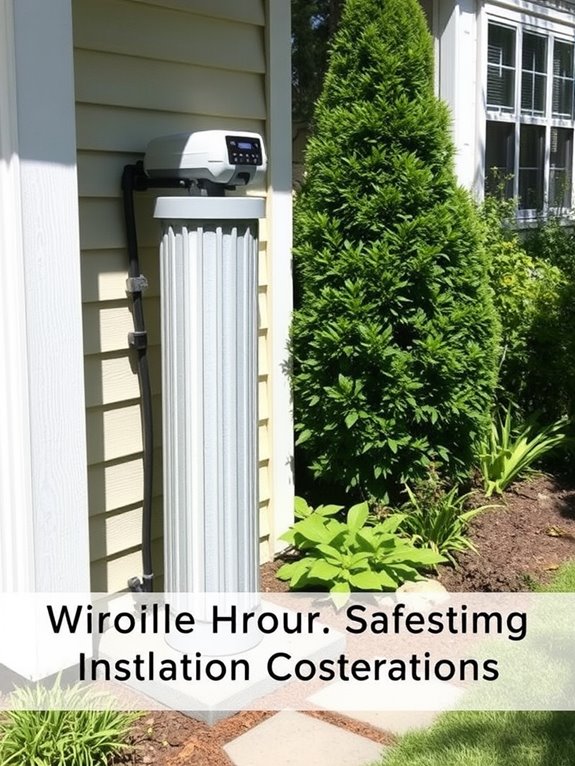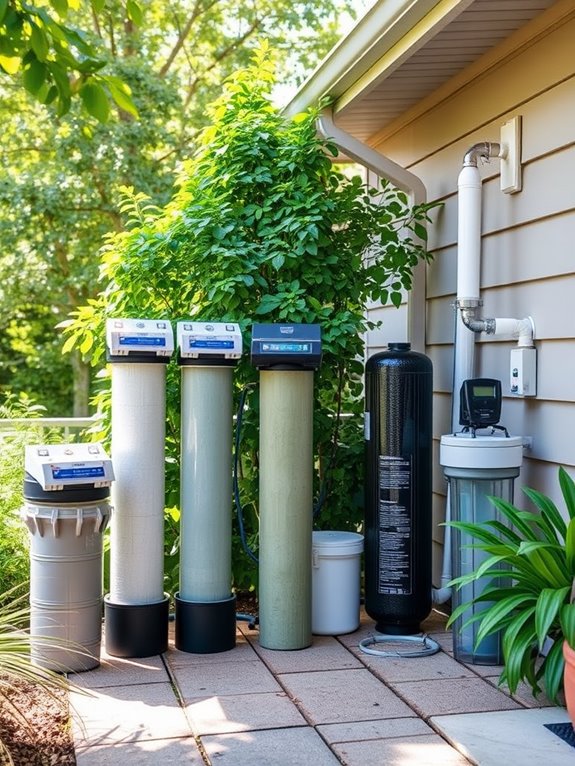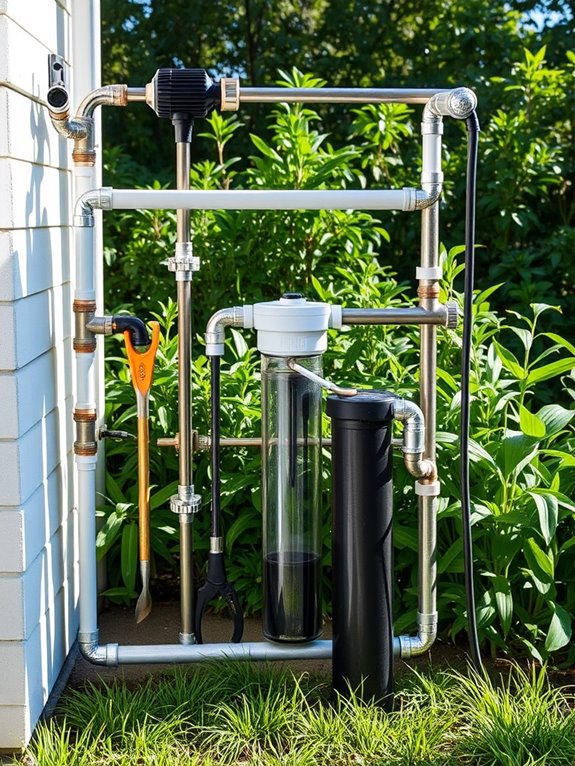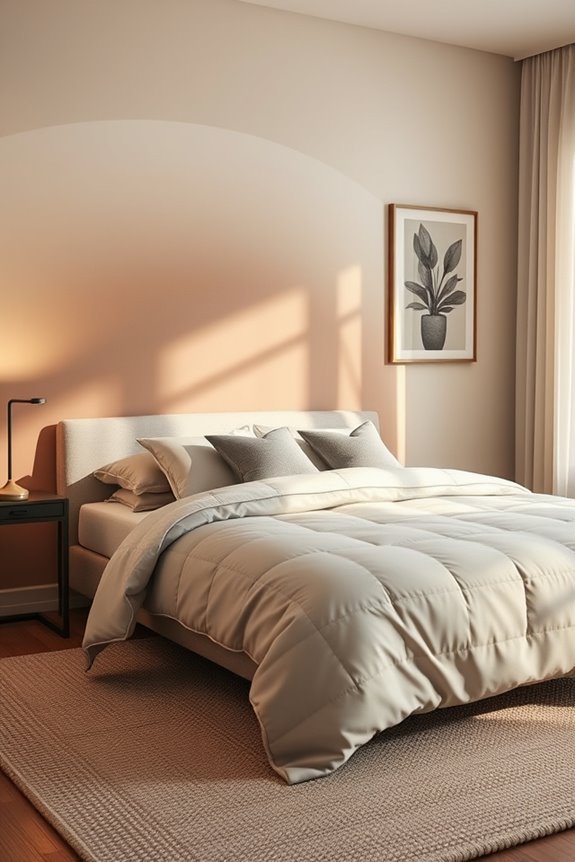Can a Whole House Water Filter Be Installed Outside? Tips and Best Practices
Yes, you can install a whole house water filter outside, and it offers benefits like saving indoor space and easier maintenance. Just make sure to take into account factors like climate and water quality before installation. Choose the right filter type and follow a straightforward step-by-step process for setup. Regular maintenance is key too—protect your filter from freezing temperatures and environmental elements. If you’re curious about the specifics, there’s plenty more to explore!
Understanding Whole House Water Filters

When you’re considering a whole house water filter, it’s crucial to understand how they work and what they offer.
These systems connect directly to your main water supply, filtering out impurities before they reach your taps. Typically, they use a combination of sediment filters, activated carbon, and sometimes reverse osmosis to purify water.
You’ll notice a difference in taste, odor, and clarity, improving overall water quality throughout your home.
Installation involves locating the right spot in your plumbing system and ensuring proper sizing and compatibility with your existing setup.
Knowing these details helps you make an informed decision for cleaner water.
Don’t miss out on related tips: Read this next: Are Water Filter Cartridges Recyclable? A Guide to Sustainable Choices
Benefits of Installing a Water Filter Outside
Installing a water filter outside can be a smart choice for your home.
It saves space indoors, reduces the risk of contamination inside, and makes maintenance much easier.
You’ll appreciate the convenience and benefits that come with this setup.
Space-Saving Installation Solution
Although many homeowners opt for indoor installations, placing a whole house water filter outside can be a smart choice that maximizes space and efficiency.
By installing your system outdoors, you free up valuable indoor space, allowing for a more open and functional home environment. This solution is especially beneficial in smaller homes or apartments where every square foot counts.
Additionally, outdoor installations can often be easier to access for maintenance, saving you time and effort.
With proper weather protection, your outdoor filter can perform just as well, making it a practical and space-saving option for your water filtration needs.
You might also be interested in: What is Potable Water Plumbing?
Reduced Indoor Contamination
By choosing to install your whole house water filter outside, you considerably reduce the risk of indoor contamination. This leads to a healthier living environment and peace of mind.
Here are some benefits of outdoor installation:
- Minimized moisture: Reduces dampness that can promote mold and mildew indoors.
- Decreased pollutants: Limits the chance of dust, dirt, and allergens entering your home.
- Less plumbing risk: Decreases the likelihood of leaks or pipe bursts affecting your indoor space.
With these advantages, you can enjoy cleaner water without compromising your indoor air quality or overall health.
Easier Maintenance Access
When you choose to install your whole house water filter outside, you gain easier access for maintenance and repairs.
This setup allows you to tackle issues without cluttering your indoor space or disrupting your daily routine. You won’t have to squeeze into tight spots or move furniture around, making maintenance quick and straightforward.
Plus, you’ll be able to visually inspect the system regularly, ensuring everything runs smoothly.
Outdoor installation also keeps your filter away from potential indoor hazards, like leaks or mold, ensuring you can focus on keeping your water clean and safe with minimal hassle.
Enjoy a more convenient maintenance experience!
Don’t miss out on related tips: Read this next: Is the Water Plumbed to Your Laundry Sink Potable?
Factors to Consider Before Installation

Before you engage in installing a whole house water filter, it’s important to contemplate several key factors that can impact the system’s effectiveness and your home’s plumbing.
Consider these points:
- Climate: Extreme temperatures can affect the filter’s performance and lifespan.
- Water Source: Understand your water quality; different filters suit different contaminants.
- Space Availability: Confirm you have enough room for installation and maintenance access.
You might also be interested in: Are All Water Filters the Same? Understanding the Key Differences
Suitable Locations for Outdoor Installation
Choosing the right location for your outdoor whole house water filter is essential for ensuring ideal performance and easy maintenance.
Look for a spot that’s close to your main water line but sheltered from extreme weather, like direct sunlight or heavy rain. Ideally, place it on a stable surface, such as a concrete pad, to prevent shifting or damage.
Avoid areas with excessive foot traffic or potential obstructions that could hinder access. Additionally, make sure it’s near a power source if your system requires electricity.
With the right location, you’ll enjoy efficient filtration and hassle-free upkeep for years to come.
There’s more to explore! Here’s another valuable read: Are Water Filter Cartridges Interchangeable? Here’s What You Should Know
Choosing the Right Type of Water Filter

Selecting the right type of water filter is essential for your home’s water quality and your family’s health.
Consider these factors when making your choice:
- Contaminants: Identify which impurities you need to remove, like chlorine, sediment, or heavy metals.
- Filter Type: Choose between options like activated carbon, reverse osmosis, or UV filtration based on your needs.
- Flow Rate: Verify the filter can handle your household’s water usage without sacrificing pressure.
There’s more to explore! Here’s another valuable read: Are Water Softener Systems Worth It? Pros, Cons, and Real-Life Reviews
Essential Tools and Materials for Installation
Before you start your whole house water filter installation, you’ll need to gather some essential tools and materials.
Make sure you have a checklist ready, including the necessary items for a smooth setup.
Don’t forget to include safety gear to protect yourself during the process.
Required Tools Overview
Installing a whole house water filter requires a few essential tools and materials to guarantee the job goes smoothly. Here’s what you’ll need:
- Pipe wrench: For gripping and turning the pipes securely.
- Teflon tape: To assure leak-proof connections.
- Adjustable pliers: For tightening fittings and valves.
Having these tools on hand will make the installation process much easier.
Make certain they’re in good condition before you start.
With the right tools, you’ll minimize potential issues and save time, allowing you to focus on enjoying your clean water.
Get these essentials ready to set yourself up for success!
Necessary Materials Checklist
When gearing up for your whole house water filter installation, having the right materials is vital.
You’ll need the water filter system itself, along with appropriate fittings and connectors for your plumbing. Don’t forget the necessary hoses or pipes, as well as Teflon tape to guarantee leak-proof seals.
A shut-off valve is important for easy maintenance, and consider a pressure gauge to monitor system performance. If you’re using a sediment pre-filter, grab that too.
Finally, keep a wrench handy for tightening connections. With these materials, you’ll be well-prepared to tackle your installation project efficiently.
Safety Gear Essentials
Safety should always be a top priority during your whole house water filter installation.
Proper safety gear helps protect you from potential hazards.
Make sure you’re equipped with the following essentials:
- Safety goggles: Protect your eyes from debris and splashes.
- Gloves: Use durable gloves to shield your hands from sharp tools and chemicals.
- Knee pads: Keep your knees comfortable and protected while working on the ground.
Here’s another post you might find useful: Best Hard Water Shower Filters: Protect Your Skin and Hair
Step-by-Step Installation Process

To successfully install a whole house water filter, you’ll want to follow a clear, step-by-step process that makes the task manageable.
First, choose the right location outside, guaranteeing it’s easily accessible. Next, turn off your water supply and drain the pipes.
Install the filter’s mounting bracket to the wall and secure it. Connect the incoming and outgoing pipes to the filter, making sure to follow the manufacturer’s instructions for proper orientation.
Then, turn the water supply back on, check for leaks, and flush the system. Finally, test the water to confirm your filter is working effectively.
You might also be interested in: Everything You Need to Know About the Amway Espring Water Filter
Maintenance Tips for Outdoor Water Filters
To keep your outdoor water filters in top shape, establish a regular cleaning schedule.
It’s also vital to protect them from freezing temperatures to prevent damage.
Regular Cleaning Schedule
While outdoor water filters can greatly enhance your water quality, they also require regular maintenance to function effectively.
Establishing a cleaning schedule is essential to guarantee peak performance.
Consider these tips for keeping your filter in top shape:
- Inspect and clean pre-filters monthly.
- Replace filter cartridges every 6-12 months, depending on usage.
- Check for debris around the filter housing weekly.
Protect From Freezing
As temperatures drop, protecting your outdoor water filter from freezing becomes essential to guarantee it operates efficiently.
Start by wrapping the filter and its pipes with insulation tape or foam. You can also use heat cables specifically designed for outdoor plumbing.
If you expect extremely low temperatures, consider draining the system completely to prevent water from freezing inside.
Additionally, make certain the area around the filter is clear of snow and ice, allowing for proper drainage.
Regularly check the insulation and heating elements throughout the winter to make certain they’re in good condition.
This proactive approach will keep your water filter safe and functional.
There’s more to explore! Here’s another valuable read: Best Reverse Osmosis Systems for Pure Drinking Water
Protecting Your Filter From Environmental Elements

Since your whole house water filter is crucial for maintaining clean water, protecting it from environmental elements is important.
To guarantee longevity and efficiency, take these precautions:
- Shade it: Use a cover or build a small shelter to shield your filter from direct sunlight.
- Elevate it: Keep the filter off the ground to prevent water pooling and potential corrosion.
- Insulate it: Use insulation materials during extreme weather to protect against heat and cold.
Here’s another post you might find useful: Do Refrigerator Water Filters Remove Fluoride? What You Need to Know
When to Call a Professional Installer
Determining when to call a professional installer can save you time and prevent costly mistakes.
If you’re unsure about your plumbing skills or the complexity of your water filter system, it’s best to seek help.
Also, if local building codes or permits are involved, a pro can navigate those requirements smoothly.
Don’t hesitate to call if you feel overwhelmed by the installation process or lack the necessary tools.
Ultimately, if you notice any complications during setup, like leaks or pressure issues, getting a professional’s expertise is a smart choice to guarantee a safe and effective installation.
Conclusion
Installing a whole house water filter outside can transform your home into a fortress of pure, clean water. By considering the right factors and following our tips, you can enjoy the multitude of benefits this system brings. Remember, protecting your filter from the elements is vital for longevity. If you ever feel overwhelmed, don’t hesitate to call a professional. With a little effort, you’ll have water that’s as invigorating as a mountain spring flowing right into your home!



